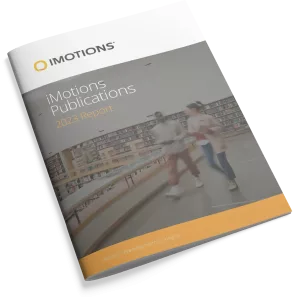-
Eye-tracking Retrospective Think-aloud as a Novel Approach for a Usability Evaluation
Abstract: Objective To report on the use of an eye-tracking retrospective think-aloud for usability evaluation and to describe its application in assessing the usability of a mobile health app. Materials and Methods We used an eye-tracking retrospective think-aloud to evaluate the usability of a HIV prevention mobile app among 20 young men (15-18 years) in […] -
A comparison of the effectiveness of two types of deceit detection training methods in older adults
Abstract: Background In general, people are poor at detecting deception. Older adults are even worse than young adults at detecting deceit, which might make them uniquely vulnerable to certain types of financial fraud. One reason for poor deceit detection abilities is that lay theories of cues to deception are not valid. This study compared the […] -
Emotional responses to climate change map framing using facial emotion recognition technology
Abstract: The different ways that maps are framed by the media can lead to different emotional responses to the same information. Framing shapes the way in which information is presented, and frames are used by authors and designers to focus the reader’s attention in order to lead them to a particular interpretation of the information […] -
Eye tracking in cytotechnology education: “visualizing” students becoming experts
This study reports the potential of eye-tracking technology in determining screening skills of cytotechnology (CT) students while examining digital images (DI). Materials and methods Twenty-five static DI of gynecologic cytology specimens were serially displayed on a computer monitor for evaluation by 16 CT students and 3 cytotechnologists at 3 locations. During evaluation, participant’s eye movements […] -
Examining Course Layouts in Blackboard: Using Eye-Tracking to Evaluate Usability in a Learning Management System
Abstract: This paper describes an exploratory usability study designed to investigate how college students locate information in a Learning Management System and to establish a set of guidelines for creating the best course layouts that can increase the student’s learning experience. Using observations, perception survey data, and a high-fidelity eye-tracker that recorded where participants’ eyes […] -
Eye-Tracking Boston City Hall to Better Understand Human Perception and the Architectural Experience
Abstract: Learning how architecture impacts human perception can help us understand how civic monuments bring us together or drive us apart, create community cohesion and identity or the reverse: anomie, placelessness and the fragmentation of the public realm. Boston City Hall and Plaza, an urban renewal project from the 1960s, intended to revitalize a historic […] -
Classification of Strategies for Solving Programming Problems using AoI Sequence Analysis
Abstract: This eye tracking study examines participants’ visual attention when solving algorithmic problems in the form of programming problems. The stimuli consisted of a problem statement, example output, and a set of multiple-choice questions regarding variables, data types, and operations needed to solve the programming problems. We recorded eye movements of students and performed an […] -
Eye Tracking as a Method of Neuromarketing for Attention Research-An Empirical Analysis Using the Online Appointment Booking Platform from Mercedes-Benz
Abstract: A good user experience can only be achieved by knowing and understanding users’ wishes, needs and cognitive abilities. The aim of this study is to find out how the user of the online appointment booking interacts with the interface as well as the visualizations. The focus is on the question of whether the new […] -
Human-virtual character interaction: Toward understanding the influence of haptic feedback
Abstract: In this study, we compare haptic feedback and nonhaptic feedback conditions in which virtual characters bump into the participant who is immersed in a virtual environment. A questionnaire was developed to determine the influence of haptic feedback on a number of concepts (presence, embodiment, positive and negative affect, interaction realism with virtual character, and […] -
FaceSync: Open source framework for recording facial expressions with head-mounted cameras
Abstract: Advances in computer vision and machine learning algorithms have enabled researchers to extract facial expression data from face video recordings with greater ease and speed than standard manual coding methods, which has led to a dramatic increase in the pace of facial expression research. However, there are many limitations in recording facial expressions in laboratory […]
Research Report 2024
In-depth look at the scientific landscape as powered by iMotions software, showcasing groundbreaking research and the impact of our tools in various scientific and industrial fields.

iMotions Science Resources
Looking for white papers, validation reports or research show casing iMotions Multimodal capabilities?
Share Your Research

850+ universities worldwide with an iMotions human behavior lab
73 of the top 100 highest ranked universities
710+ published research papers using iMotions
iMotions is used for some of the most interesting human behavior research studies carried out by top researchers around the world. Contact us to have your publication featured here.
The authors of these publications have used iMotions as a software tool within their research.
“Software should be cited on the same basis as any other research product such as a paper or a book; that is, authors should cite the appropriate set of software products just as they cite the appropriate set of papers” (Katz et al., 2020).
We therefore encourage you to cite the use of iMotions where appropriate.
How to cite iMotions
APA
iMotions (10), iMotions A/S, Copenhagen, Denmark, (2024).
Note: adjust the version and year where relevant.
5 Most Popular Blogs
Publications
Read publications made possible with iMotions
Blog
Get inspired and learn more from our expert content writers
Newsletter
A monthly close up of latest product and research news


